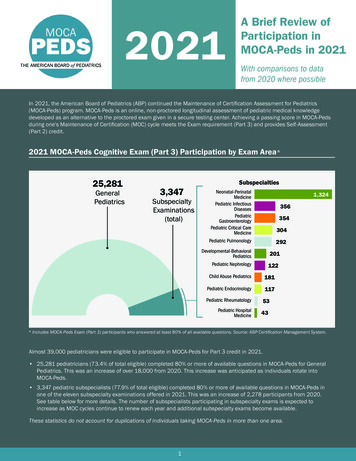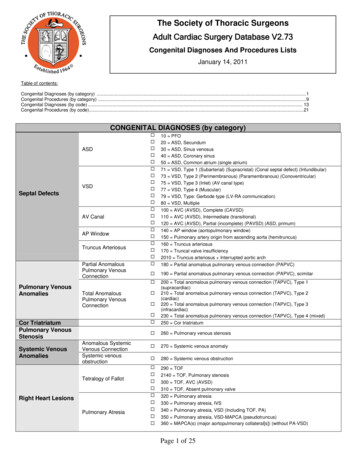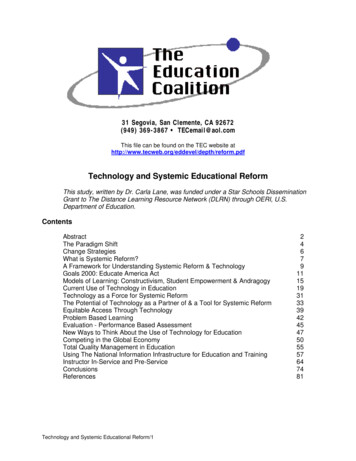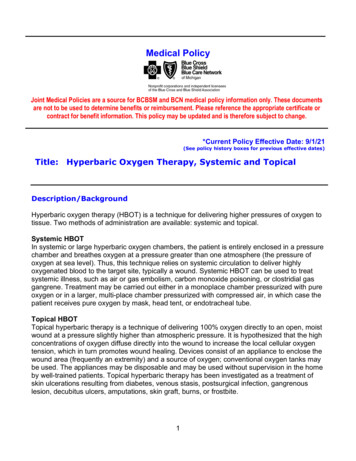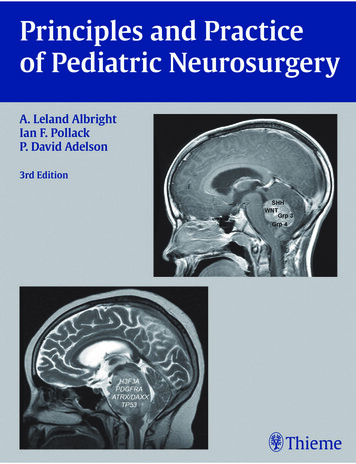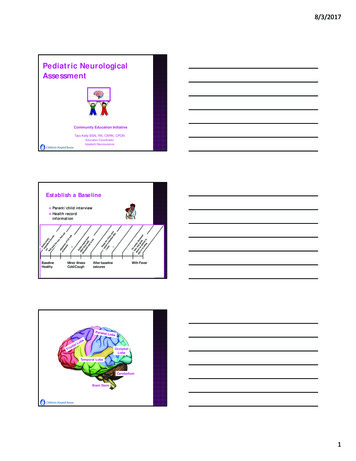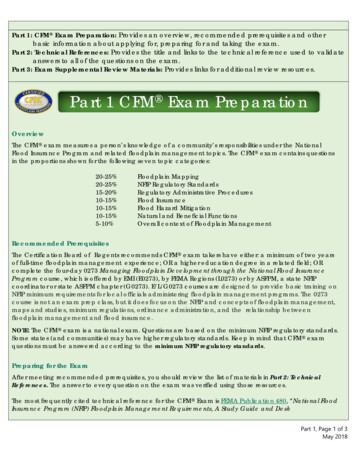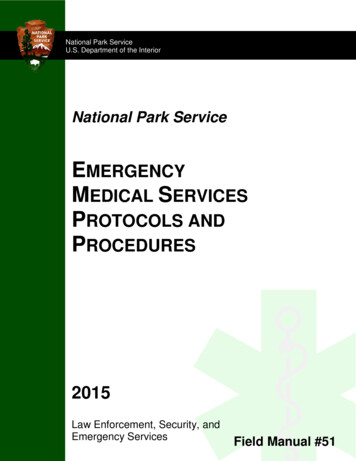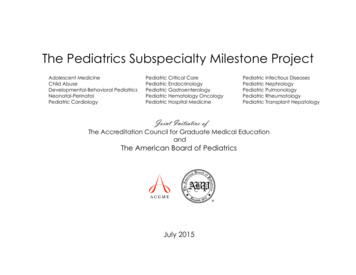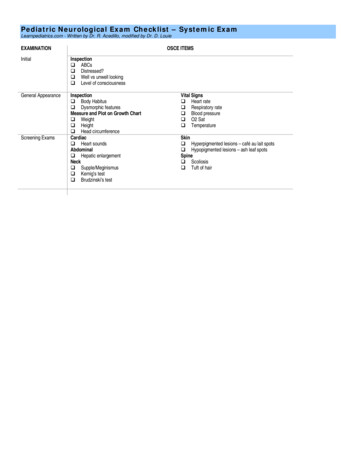
Transcription
Pediatric Neurological Exam Checklist – Systemic ExamLearnpediatrics.com - Written by Dr. R. Acedillo, modified by Dr. D. LouieEXAMINATIONOSCE ITEMSInitialInspection ABCs Distressed? Well vs unwell looking Level of consciousnessGeneral AppearanceInspection Body Habitus Dysmorphic featuresMeasure and Plot on Growth Chart Weight Height Head circumferenceCardiac Heart soundsAbdominal Hepatic enlargementNeck Supple/Meginismus Kernig’s test Brudzinski’s testScreening ExamsVital Signs Heart rate Respiratory rate Blood pressure O2 Sat TemperatureSkin Hyperpigmented lesions – café au lait spots Hypopigmented lesions – ash leaf spotsSpine Scoliosis Tuft of hair
Pediatric Neurological Exam Checklist – Mental Status (for children 7 yrs)Learnpediatrics.com - Written by Dr. R. Acillo, modified by Dr. D. Louie*Mini-mental Status Exam (MMSE) items where indicated in italics (value of MMSE items also shown)EXAMOSCE ITEMS (use as necessary to test each component of the exam)Inspection1. Level of Alertness, Attention and Cooperation Spell WORLD forwards and backwards (MMSE 5) Digit span (minimum 6 forward, 4 backward) Name months forwards and backwards2. Orientation Person’s name, day, month, season, year (MMSE 5) Floor, hospital, city, province, country (MMSE 5)3. Concentration and Memory Recent memory: Recall three items (MMSE 3) fromlanguage tests (see below) Remote memory: Any historical or verifiable personalevents (birth date, prime ministers, etc)6. Apraxia Pretend to comb your hair Pretend to brush your teeth Pretend to hammer a nail Pretend to strike a match and blow it out7. Non-dominant Parietal Functions (Neglect andConstructions) Neglect: Neglect drawing test (clock, line-cut-in half),extinction double simultaneous stimulation, look foranosoagnosia Construction: Copy complex drawing (e.g. house, twopentagons, clock test [additional MMSE challenge]) Dressing4. Language Spontaneous speech: Fluency, phrase length,abundance, paraphasic errors (inappropriate substitutedwords), neologisms, errors in grammar, prosody Comprehension: Logical thinking, abstract thinking(include simple questions and 3-step commands[MMSE 3]) Naming: Identify easy objects (pen, watch etc –MMSE 2) and difficult ones (fingernail, stethoscope, etc). Repetition: “No if’s, and’s, or but’s” (MMSE 1, repeatthree words “cat, red, baseball”, etc (MMSE 3) Reading/Obeying: Read aloud single words, briefpassage, paragraphs, read and obey ([MMSE 1] test forcomprehension) Writing: Ask patient to write their name and a sentence(MMSE 1, copy design (MMSE 1)8. Sequencing Tasks and Frontal ReleaseSigns/Frontal Lobe Dysfunction Perseveration: Written or manual alternatingsequencing task) Motor impersistence: “Raise your arms”, “look to yourright”, auditory Go-No-Go tests Frontal release signs: Changes in personality, graspreflex5. Non-Language Dominant Parietal(Gertsmann’s Syndrome) Calculations: simple addition, subtraction (100 minus 7,etc – MMSE substitute for “WORLD”) R/L Confusion: identify body parts, obey commands(“take your right finger and touch your left ear”) Finger agnosia: Name and identify each digit Agraphia: Write name and sentence (see language)11. Mood Signs of depression, anxiety, or mania Mood, changes in eating, sleeping patterns, loss ofenergy, loss of motivation and initiative, low selfesteem, poor concentration, lack of enjoyment ofpreviously pleasurable activities, self-destructive orsuicidal thoughts and behaviours.9. Logic and Abstraction Problem solving, series generation (AZ BY, CX) Abstract thinking (proverb interpretation)10. Hallucinations and Delusions Auditory or visual hallucinations (ask them questions) Delusions (ask them questions)
Pediatric Neurological Exam Checklist – Cranial NervesLearnpediatrics.com - Written by Dr. R. Acillo, modified by Dr. D. LouieEXAMInspection/PalpationOSCE ITEMS (use as necessary to test each component of the exam)1. OLFACTION (CN I) Any non-noxious odor (test each nostril separately)2. VISION (CN II) Visual acuity (wear corrective lenses, eye chart, one eye ata time) Colour vision (name colour of objects) Visual fields (test quadrants, for each eye, have patientdetect moving fingers or number of fingers; blink-to-threatin comatose or uncooperative patients) Visual extinction on double simultaneous stimulation (testfor neglect) Retinal examination (optic neuritis, papilledema, etc)3. PUPILLARY RESPONSES (CN II, III) Direct and consensual responses to light Accommodation (pupils constrict when fixated on object) Swinging flashlight test (afferent papillary defect) Argyll-Robertson (near light dissociation) pupils, Horner’ssyndrome, Parinaud’s syndrome4. EXTRAOCULAR MOVEMENTS (CN III, IV, VI) Smooth pursuit: H-test (nystagmus, delay of movement,lack of movement, ability to track, dysconjugate gaze,gaze palsy, Parinaud’s, INO) Convergence (make the patient cross eyed) Saccades (switch between two objects) Oculo-cephalic and caloric testing (comatose patients)5. FACIAL SENSATION/MUSCLES OF MASTICATION (CN V) Light touch (tissue) and temperature Tactile extinction on double simultaneous stimulation Corneal reflex (includes CN VII) Jaw jerk reflex (presence is abnormal)6. MUSCLES OF FACIAL EXPRESSION AND TASTE (CN VII) Asymmetry and depth of folds (e.g. nasolabial) Ask patients to smile, puff out cheeks, clench eyes, wrinkleforehead. Check taste on anterior part of tongue7. HEARING AND VESTIBULAR SENSE (CN VII, CN VIII) Sound detection (finger rubs, whisper words) Whine and Weber tests (mechanical vs conductionabnormalities) Vestibulo-ocular reflex, caloric testing when indicated8. PALATE ELEVATION AND GAG REFLEX (CN IX, X) “Ahhhhhhhhh” Gag reflex Check taste on posterior part of tongue9. MUSCLES OF ARTICULATION (CN V, VII, IX, X, XII) Dysarthria vs dysphasia10. STERNOCLEIDOMASTOID/TRAPEZOID (CN XI) Shrug shoulders Turn head in both directions Flex neck when supine11. TONGUE MUSCLES (CN XII) Atrophy or fasiculations Unilateral tongue weakness
Pediatric Neurological Exam Checklist – Motor, Sensory, ReflexesLearnpediatrics.com - Written by Dr. R. Acillo, modified by Dr. D. LouieEXAMInspectionPalpationOSCE ITEMSVisible abnormalities Hypertrophy Wasting Seizure activity ChoreaStrength UPPER EXTREMITYFingers (resist force) Abduct little finger (C8, T1) Grip your fingers (C7, C8) Make an “O” (C6, C7, C8) MP joint extension (C7, C8)Wrist Extension (C6, C7) Flexion (C7, C8)Elbow Flexion (C5, C6) Extension (C6, C7, C8)Shoulder Shoulder external rotation (elbow’s flexed 90 )(C5, C6) Shoulder abduction (C5, C6) Shoulder shrug (XI, C3-5)Thumb Abduction (plane of palm)(radial nerve C7, C8) Adduction (plane of palm)(ulnar nerve C8, T1) Abduction (perpendicular to palm) (mediannerve C8, T1) Opposition (median nerve C8, T1) Fasciculation Tremor (postural, intention, resting, etc)Strength LOWER EXTREMITYPatient (do with gait) Heel walk (L4, L5) Toe walk (S1, S2)Foot (resist force) Toes extension (L5, S1) Great toe flexion (S1) Foot inversion (L4, L5) Foot eversion (L5, S1) Foot extension (L4, L5) Foot flexion (S1, S2)Reflexes LOWER EXTREMITY Knee jerk (L2, L3, L4) Posterior tibialis (L5) Ankle jerk (S1) Babinski sign Crossed adductionReflexes UPPER EXTREMITY Biceps (C5) Brachioradialis (C5, C6) Triceps (C7) Finger flexors (C8)OtherComponentsMuscle Power0 none1 flicker2 move with no gravity3 against gravity4 against some resistance5 against resistanceMuscle Tone Normal Spasticity and clonus Rigidity and cogwheel HypotoniaDeep Tendons Reflexes0 absent1 trace2 normal3 brisk4 clonus (non-sustained)5 sustained clonus Athetosis DystoniaKnee (resist force) Knee extension (L2-L4) Knee flexion (S1, S2)Hip (resist force) Hip flexion (L1-L3/L4) Hip extension (L5, S1) Hip adduction (L2-L4) Hip abduction (L5)
Pediatric Neurological Exam Checklist – Motor, Sensory, ReflexesLearnpediatrics.com - Written by Dr. R. Acillo, modified by Dr. D. LouieEXAMPalpationOSCE ITEMSSensory LOWER EXTREMITY Perianal (S2-S4) Lateral/sole of foot (S1) Dorsum of foot/1st web space (L5) Medial ankle and shin (L4) Medial thigh above patella (L3) Anterior mid thigh (L2) Lateral thigh below inguinal ligament (L1)Sensory UPPER EXTREMITY Medial arm near elbow (T1) Little finger, distal radial border,dorsal base of thumb near web space (C8) Middle finger (C7) Lateral forearm (C6) Lateral arm/deltoid (C5)Modalities Touch Pain Temperature Vibration Proprioception Cortical sensation stereognosis tactile discrimination graphesthesia
Pediatric Neurological Exam Checklist – Coordination and GaitLearnpediatrics.com - Written by Dr. R. Acillo, modified by Dr. D. LouieEXAMSupineOSCE ITEMSCerebellar SystemCoordination of Extremities Upper extremity: Finger-to-nose (change location,assess accuracy and speed) Lower extremity: Heel-knee-shin testFine Finger/Hand Movements Rapid thumb-to-index finger tapping Rapid hand taping (against examiner – assess rate,rhythm, depth/force of tapping) Screw light bulb actions Rapid alternative movements (dorsum tap-to-palm tap)StandingBalance and GaitBalance Romberg test (stand and close eyes)Gait (Regular, Tandem, Forced*) Stance (width of feet), posture, stability Raise of foot off ground, circumduction (arched medial tolateral swing of legs), leg stiffness, knee bend, arm swing Rate and speed, tendency to fall, difficulty initiatingwalking Involuntary movements and turns* Forced gait walk on heels/walk on toesObserve and Recognize Dysdiadochokinesia (slow, irregular, clumsy movements)tested by rapid alternating movements Dysmetria (past pointing/overshoot, intention tremor) testedby finger-to-nose and heel-knee-shin tests Ataxic movementsObserve and Recognize Cerebellar ataxia: Appendicular (lateral cerebellarhemispheres) vs trunkal (vermis e.g. alcohol intoxication)(Wide based gait, difficulty with tandem gait) Sensory ataxia: Dorsal column (overshoot, wide-basedsteady gait much worse with eyes closed) Gait apraxia: For some perplexing reason, patient canperform the actions of walking while supine, but can’t do itfor real when standing. Foot drop: Peripheral nerve lesion Spastic gait: Unilateral or bilateral corticospinal tract (stiffedlegged, circumduction, unsteady, tendency to fall towardsside of spasticity) Parkinsonian gait: Basal Ganglia/substantia nigra lesion(slow, shuffling narrow gait, difficulty initiating walk) Myopathic gait: Due to muscle pathologys (waddling andlurching gait, Trendelenburg’s sign)
Pediatric Neurological Exam Checklist - Mental Status (for children 7 yrs) Learnpediatrics.com - Written by Dr. R. Acillo, modified by Dr. D. Louie *Mini-mental Status Exam (MMSE) items where indicated in italics (value of MMSE items also shown) EXAM OSCE ITEMS (use as necessary to test each component of the exam) Inspection 1.
